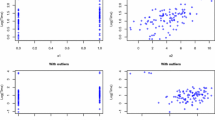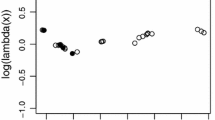Abstract
The semiparametric accelerated failure time (AFT) model is a popular linear model in survival analysis. AFT model and its associated inference methods assume homoscedasticity of the survival data. It is shown that violation of this assumption will lead to inefficient parameter estimation and anti-conservative confidence interval estimation, and thus, misleading conclusions in survival data analysis. However, there is no valid statistical test proposed to test the homoscedasticity assumption. In this paper, we propose the first novel quasi-likelihood ratio test for the homoscedasticity assumption in the AFT model. Simulation studies show the test performs well. A real dataset is used to demonstrate the usefulness of the developed test.


Similar content being viewed by others
References
Breusch TS, Pagan AR (1980) A simple test for heteroscedasticity and random coefficient variation. Econometrica 47:1287–1294
Buckley J, James I (1979) Linear-regression with censored data. Biometrika 66(3):429–436
Cai ZW, Hurvich CM, Tsai CL (1998) Score tests for heteroscedasticity in wavelet regression. Biometrika 85(1):229–234
Cook RD, Weisberg S (1983) Diagnostics for heteroscedasticity in regression. Biometrika 70(1):1–10
Cox DR (1972) Regression models and life-tables. J R Stat Soc Ser B 34:187–202
De Boor C (1978) A practical guide to splines. Springer, New York
Greene W (2008) Econometric analysis, 6th edn. Prentice Hall, Upper Saddle River
Hardle W, Mammen E (1993) Comparing nonparametric versus parametric regression fits. Ann Stat 21(4):1926–1947
Huang JZ (2006) Polynomial spline estimation and inference of proportional hazards regression models with flexible relative risk form. Biometrics 62:793–802
Jin ZZ, Lin DY, Wei LJ, Ying ZL (2003) Rank-based inference for the accelerated failure time model. Biometrika 90(2):341–353
Jin ZZ, Lin DY, Ying ZL (2006) On least-squares regression with censored data. Biometrika 93(1):147–161
Kalbfleisch DJ, Prentice LR (1980) The statistical analysis of failure time data. Wiley, New York
Lai TL, Ying ZL (1991) Large sample theory of a modified Buckley–James estimator for regression-analysis with censored-data. Ann Stat 19(3):1370–1402
Lai TL, Ying ZL (1992) Linear rank statistics in regression-analysis with censored or truncated data. J Multivar Anal 40(1):13–45
Lin DY, Ying ZL (1995) Semiparametric inference for the accelerated life model with time-dependent covariates. J Stat Plan Inference 44(1):47–63
Meier P (1975) Estimation of a distribution function from incomplete observations. Perspectives in probability and statistics. Academic Press, London, pp 67–87
Muller HG, Zhao PL (1995) On a semiparametric variance function model and a test for heteroscedasticity. Ann Stat 23(3):946–967
Reid N (1994) A conversation with sir david cox. Stat Sci 9:439–455
Ritov Y (1990) Estimation in a linear regression model with censored data. Ann Stat 18:303–328
Robins J, Tsiatis AA (1992) Semiparametric estimation of an accelerated failure time model with time-dependent covariates. Biometrika 79(2):311–319
Wang L, Zhou XH (2005) A fully nonparametric diagnostic test for homogeneity of variances. Can J Stat 33(4):545–558
Wang L, Zhou XH (2007) Assessing the adequacy of variance function in heteroscedastic regression models. Biometrics 63(4):1218–1225
Wedderburn RWM (1974) Quasi-likelihood functions, generalized linear-models, and Gauss–Newton method. Biometrika 61(3):439–447
Ying ZL (1993) A large-sample study of rank estimation for censored regression data. Ann Stat 21(1):76–99
Yu LL (2011) Nonparametric quasi-likelihood for right censored data. Lifetime Data Anal 17(4):594–607
Yu LL, Peace KE (2012) Spline nonparametric quasi-likelihood regression within the frame of the accelerated failure time model. Comput Stat Data Anal 56(9):2675–2687
Yu LL, Yu R, Liu L, Chen D (2012) Extended quasi-likelihood with fractional polynomials in the frame of the accelerated failure time model. Stat Med 31(13):1369–1379
Yu LL, Liu L, Chen D (2013) Weighted least-squares method for right-censored data in accelerated failure time model. Biometrics 69(2):358–365
Zhou M (2005) Empirical likelihood analysis of the rank estimator for the censored accelerated failure time model. Biometrika 92(2):492–498
Zhou M, Kim M, Bathke A (2012) Empirical likelihood analysis for the heteroscedastic accelerated failure time model. Stat Sin 22:295–316
Acknowledgements
We are grateful to the editor, associate editor, and two referees for their insightful comments, which significantly improved this manuscript.
Author information
Authors and Affiliations
Corresponding author
Electronic supplementary material
Below is the link to the electronic supplementary material.
Supplementary Materials
The R-code for the new test is available on request from the corresponding author.
Rights and permissions
About this article
Cite this article
Yu, L., Liu, L. & Chen, DG. A homoscedasticity test for the accelerated failure time model. Comput Stat 34, 433–446 (2019). https://doi.org/10.1007/s00180-018-0840-9
Received:
Accepted:
Published:
Issue Date:
DOI: https://doi.org/10.1007/s00180-018-0840-9




